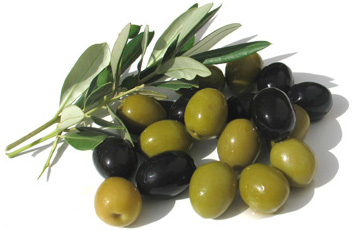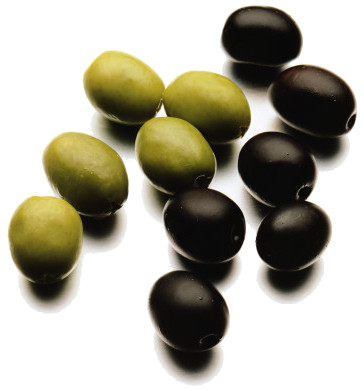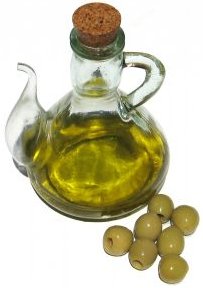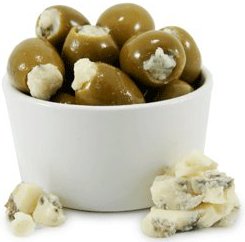

Olives

Olea. (From Greek elaia, the olive.) OLIVE. Oleaceae. Some twenty species of long-lived evergreen trees and shrubs, to 20m. Stems smooth or rough to spiny, glossy, golden-glabrous to silver-grey, slender and pliable at first, later becoming fissured and rigid and, in advanced maturity, blackened and contorted. Leaves opposite, entire or, rarely, irregularly toothed and lobed, ovate to elliptic, to 8cm long, grey to dark green, glabrous above, coriaceous and somewhat thickened; paler beneath, often glandular or silver-scurfy. Axillary or terminal panicles of white or off-white flowers borne in summer. Flowers inconspicuous, seldom over 1cm, with a musty fragrance, unisexual or bisexual; calyx and corolla short, 4-lobed; stamens 2; ovaries usually 2. Fruit carried in clusters, ovoid or globose drupes containing a single, ellipsoid stone to 1.5cm. Temperate and tropical Old World. CultivationOne of the most important economic plants of semi-dry and dry regions, the olive provides fruit, oil, timber and emblems of peace. It also stabilises the dusty, often hilly soils on which it grows and appeals to the gardener through its fine silvered foliage, its longevity and, eventually, its ornamental gnarled habit. Olea europaea variety europaea and its cultivars, which bear the surperior-quality fruit of commercial cultivation, are grown in orchards throughout the Mediterranean, in the southwestern US, South America, South Africa and Australia. Young bare-rooted trees are pruned hard at planting, and their stems whitewashed to reflect light and heat, to reduce sun scorch. They begin to bear at about six years of age, with an expected commercial lifespan of around 50 years. Flower initiation is dependent upon a 12 to 15-week period of diurnally fluctuating temperatures, with at least two months of average temperatures below 10ºC. The flowers, which may be perfect or male only, are wind-pollinated, and moderate levels of humidity are necessary for good fruit set. Although the olive is naturally drought-resistant and survives in infertile soils, heavy cropping is linked to annual rainfall levels of 60-75cm and in a regime of feeding and irrigation, coupled with systematic thinning to 3-4 fruits per 30cm of branch; this may be achieved by means of hormone sprays, or by hand. Table olives are harvested in autumn, with the main crop following in winter, raw olives being processed by soaking in sodium hydroxide (caustic soda), to remove bitter principles, and preserved in brine or olive oil. 
Olea generally requires a frost-free environment - even mature plants will be badly damaged by temperatures lower than -10ºC. Most species however, will tolerate short exposures to freezing conditions and Olea europaea will grow in zone 8, afforded the shelter of a wall and full sunlight, although good fruiting can be expected only in warm-temperate regions with moist winters and hot dry summers. Plant in a deep fertile soil, with perfect drainage, incorporating rubble and sharp sand where necessary. The weighting or arching of branches will encourage fruiting, but pruning may stimulate the overproduction of non-fruiting water shoots. In cool-temperate zones, Olea europaea can be grown in the cool greenhouse, in the border, or in a well-crocked large pot, with a free draining mix of loam based potting medium with sharp sand. Its slender branches clothed with silvery foliage (and considerable drought tolerance) make it a good choice for a large interior with dry air. Propagate by seed sown in gentle heat in spring, by semi-ripe cuttings in summer, or by layering. Grafting on to stock of Osmanthus may have a useful dwarfing influence. Susceptible to scale insect (Saissetia oleae), peacock spot fungus, (Cycloconium oleaginum), verticillium wilt (resistant rootstocks are available) and the bacterial disease ‘black knot’ (Pseudomonas savastanoi). Olea europaeavariety europaea. COMMON OLIVE; EDIBLE OLIVE. Much-branched tree to 7m. Stems semi-terete. Leaves to 8cm, elliptic to lanceolate, grey-green above, scurfy, silver-green beneath. Flowers off-white, fragrant, in axillary panicles to 5cm. Fruit subglobose, ripening red to purple-black, to 4cm. Summer. Mediterranean. Olea europaea variety europaea is the fruit and oil-yielding cultigen. Cultivars include: (oil producing) ‘Cipressino’ (‘Pyramidalis’): pyramidal in growth; fruit profuse when young. ‘Coratina’: self-fertile, erect habit. ‘Frantoio’ (‘Frantoiana’, ‘Corregilo’, ‘Razzo’): shoots pendulous; fruit large, fleshy, ovate. ‘Leccino’: large mauve fruit carried on drooping branches, semi-hardy. ‘Moraiolo’: hardy and strong-growing. (edible) ‘Ascolana’: large, yellow. ‘Cucco’: fruit black, prolific. ‘El Greco’: fruit large, stones small. ‘Manzanillo’: crown rounded, open-branched; leaves leathery; fruit black. ‘Mission’: vigorous, prolific, very cold resistant. ‘Santa Caterina’: fruit large, ovate. ‘Uovo di piccone’: purple-red, very sweet. (ornamental) ‘Littile Ollie’: bushy dwarf, fast-growing when young; leaves very dark green, no flowers; heat-resistant and drought-resistant. ‘Majestic Beauty’: open and refined in growth; leaves lighter and narrower, no mature fruit. ‘Picholine’: vigorous, medium-sized, cured olives with nut-like flavour. variety oleaster. WILD OLIVE. To 5m with rigid, spinose stems; fruit small, to 1.5cm, subglobose, thinly fleshed, inedible. subspecies africana. Resembling Olea europaea variety europaea but fruit smaller, harder. To 8m with warty grey stems. Leaves to 10cm, linear-lanceolate with yellow scurf beneath. Flowers in axillary panicles to 5cm. Fruit globose, to 0.5cm. S Africa. subspecies cuspidata. To 9m. Leaves 5-10cm, oblong-lanceolate, acuminate, glossy above, red-brown and scaly beneath. Flowers off-white in axillary cymes 2.5-5cm, corolla deeply lobed. Fruit ovoid, black, to 0.8cm. NW Himalaya, Arabia. Z8. Olives are harvested in autumn. More specifically, green olives are picked at the end of September to about the middle of November. Blond olives are picked from the middle of October to the end of November and Black olives are collected from the middle of November to the end of January or early February. In southern Europe, harvesting is done for several weeks in winter, but the time varies in each country, with the season and cultivar. 
Freshly picked olives are not tasty because they contain phenolic compounds and oleuropein, a glycoside which makes the fruit rather bitter although not unhealthy. One exception is the Thassos Olive, which can be eaten fresh. There are many ways of processing olives for eating. Traditional methods use the natural microflora on the fruit and procedures which select for those floras that ferment the fruit. This fermentation leads to three important outcomes: the leeching out and breakdown of oleuropein and phenolic compounds; the creation of lactic acid, which is a natural preservative; and a complex of flavoursome fermentation products. The result is a product which will store with or without refrigeration. One basic fermentation method involves a 10% solution of salt and vinegar in water. The ratio is 10kg olives to 7lts of water, 800g salt and 300ml of vinegar. Fresh are often sold at markets. Olives can be used green, ripe green (a yellower shade of green, or green with a hint of colour), through to full purple black ripeness. Olives should be selected for general good condition and for firmness if green. The olives are soaked in water to wash, then drained. 7lts of room temperature water is added to a container, plus 800g of sea salt and one cup (300g) of white wine or cider vinegar. Each olive is slit deeply with a small knife; large fruit (e.g. 60 fruit per kg) should be slit in multiple places. After some weeks, the salinity drops from 10% to around 5-6% once the water in the olives moves into solution and the salt moves into the olives. The olives are weighed down with an inert object such as a plate so they are fully immersed and lightly sealed in their container. The gases of fermentation should be able to escape. It is possible to use a plastic bag partially filled with water, and lay this over the top as a venting lid which also provides a good seal. The exclusion of oxygen is helpful, but not as critical as when fermenting grapes to produce wine. The olives are edible within two weeks to a month, but can be left to cure for up to three months. They can be tasted at any time because the bitter compounds are not poisonous, and oleuropein is a useful antioxidant in the human diet. Curing can be done by several methods: lye-curing, salt-curing, brine-curing and fresh water-curing. Lye-curing, an unnatural method, results in the worst taste as it leeches much of the flavour. Salt-curing (also known as dry-curing) involves packing the olives in plain salt for at least a month, which produces a salty and wrinkled olive. Brine-curing involves placing the olives in a salt water solution for a few days or more. Fresh-water curing involves soaking the olives in a succession of baths, of which the water is changed daily. Green olives are usually firmer than black olives. Olives can also be flavoured by soaking them in various marinades, or removing the pit and stuffing them. Popular flavourings are herbs, spices, olive oil, feta, blue cheese, capsicum (pimento), chilli, lemon zest, lemon juice, garlic cloves, wine, vinegar, juniper berries and anchovies. Sometimes, the olives are lightly cracked with a hammer or a stone to trigger fermentation. This method of curing adds a slightly bitter taste.
|
Home
Grow Nuts
Grow Herbs
Grow Fruit
Cyberian Index
If you like this website and want one of your own contact
Cyberian All information correct at
time of publication and open to updates as necessary. No part of this website,
or its vectors, may be produced in any shape or form, using any type or design
of medium, system, equipment or otherwise without the prior written consensual
notice of the Cyberian. Any breach of these requirements will result in the
appropriate action. If in doubt, e-mail contact is recommended.
Some components of this website were obtained as open-source software and are
used in the same non-profit manner on this website.